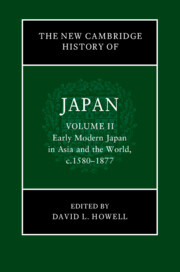Book contents
- The New Cambridge History of Japan
- The New Cambridge History of Japan
- The New Cambridge History of Japan
- Copyright page
- Contents
- Figures
- Maps
- Tables
- Contributors to Volume II
- Preface
- Frontispiece
- Introduction
- Part I The Character of the Early Modern State
- PART II Economy, Environment, and Technology
- Part III Social Practices and Cultures of Early Modern Japan
- Index
- References
Introduction
Genealogies of Japanese Early Modernity
Published online by Cambridge University Press: 15 January 2024
- The New Cambridge History of Japan
- The New Cambridge History of Japan
- The New Cambridge History of Japan
- Copyright page
- Contents
- Figures
- Maps
- Tables
- Contributors to Volume II
- Preface
- Frontispiece
- Introduction
- Part I The Character of the Early Modern State
- PART II Economy, Environment, and Technology
- Part III Social Practices and Cultures of Early Modern Japan
- Index
- References
Summary
I introduce this volume of the New Cambridge History of Japan with two questions: How is it that Anglophone scholars have come to refer to the Tokugawa period (1603–1868) and immediately surrounding years as Japan’s “early modern” period? And does calling the period early modern suggest something fundamentally different from the term used in Japanese, kinsei? When the first Cambridge History of Japan was published, in 1991, the answer to the latter question was yes: the kinsei of “the Japanese” was “more feudal than modern,” whereas the early modernity of “Western historians” was “more modern than feudal.” As this introduction demonstrates, however, the term kinsei has nothing to do with feudalism. The evolution of the terms of periodization used to refer to the Tokugawa era tell us something important about the global history of conceptualizing historical time, particularly the surprising career of modernity.
Keywords
- Type
- Chapter
- Information
- The New Cambridge History of Japan , pp. 1 - 12Publisher: Cambridge University PressPrint publication year: 2023

